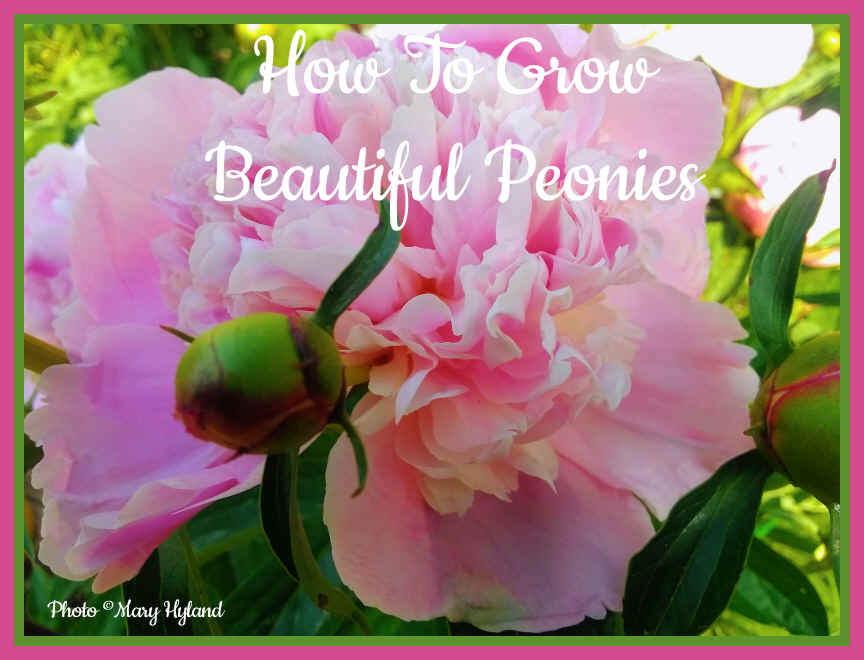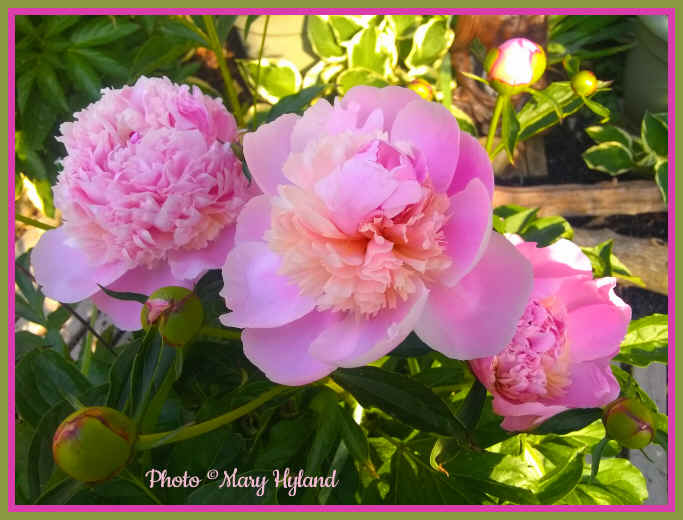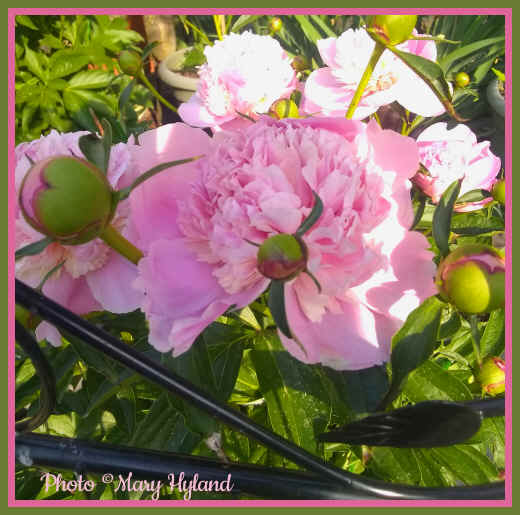 |
|
Peony Folkore
Peonies are very sexy flowers. They're beautiful, prolific, and their scent is intoxicating. Here's a little bit about growing them, along with photos of my pretty blooms. Mine grow beautifully in-ground, as well as in raised garden beds, large deck pots, and in big fabric pots (5 gallon). The fabric pots are nice because they have handles and they're lightweight. I can move them to different parts of the garden, or onto the patio if I'm having a gathering. Peonies don't require much, but you will have to stake, trellis or tie them. The blooms are heavy, some stems have two or three heavy blooms, and the stems are narrow and tall. The bloom can easily break the stem. Some of my plants are happy being staked and tied against ornamental fencing. Peonies are beautiful additions to a Romantic Garden, Fragrance Garden, Moonlight Garden, Victorian, Asian, Cutting Gardens and Cottage Gardens. Along with the advice below that is typically given for those who wish to grow peonies, I'll include my own experience. Sometimes things are easier or harder than suggested, and not all advice suits every garden's conditions or quality of plant. I also eliminate certain "duties" from care lists, because I honestly haven't had to follow that advice. If there's an easier successful way, I have found it. There are lots of flower types and colors. White, pink, peach, yellow, magenta, deep reds, and bi-colors. I find them very ornate, in a Victorian and Cottage Garden style. They are quite common in Japanese gardens. I grow them in my zen gardens, along with irises, wisteria, juniper and bamboo. And they are much tougher and are more reliable bloomers than gardeners are sometimes led to believe. Peonies thrive on a bit of innocent neglect, and they don't need dividing for a long time, if ever. They do not like transplanting, anyway. Some have an intoxicating rose-like scent, and others are lemony or unscented. I have to have fragrance. That's why I grow peonies in the first place. A vase full fills the house with a sweet rose-like scent. On warm evenings, the peony bed's fragrance floats through the backyard. Peonies are usually sold as bare-root tubers with 3 to 5 eyes (buds), and are divisions of a 3- or 4-year-old plant.Space peonies 3 to 4 feet apart to allow for good air circulation between the plants. Stagnant, humid air can produce mildew on the leaves. Deadhead peony blossoms as soon as they begin to fade, and cut the foliage to the ground in the fall. The peony dies down to the ground, and the tuber goes through winter like a champ. Shoots begin growing up in my gardens (zone 6) in late March. My peonies usually bloom the third week of May. |
 |
 |
|
Planting The Peonies Easy. Dig a generous-sized hole in well-drained soil in a sunny spot. Set the root so the eyes face upward, on top of a mound of soil in the hole, placing the roots just 2 inches below the soil surface. Donít plant too deep.Backfill the hole, taking care that the soil doesnít settle and bury the root deeper than 2 inches. Tamp the soil gently. When planting a container-grown peony, cover it no deeper than it grew in the pot. Peony plants will need well-drained, neutral soil away from competing tree roots. This plant will grow to cover an area about 3 feet in diameter so make sure you give it plenty of room. Once planted, it can remain undisturbed for many years as long as it is flowering well. Planting depth is critical; if planted too deeply it wonít bloom. Planting instructions are included with your tubers. When planting a container-grown peony, cover it no deeper than it grew in the pot. Water thoroughly. If planting in tubs or pots, water until the water runs out of the bottom of the pot. Peonies don't seem to be picky about how much water they get, either. During heat waves, I use a soaker hose around the base of the plants. They do not respond well to transplanting, so you should plan your planting site accordingly. It is suggested that you plant peonies in the fall: in late September and October in most of the U.S. I have planted mine with great success in spring or fall. If you purchase high-quality tubers with at least 3 "eyes", or a potted plant, it shouldn't matter when you plant it. If you must move a mature plant, fall is the time to do it. Peonies should be settled into place about six weeks before the ground freezes. Make sure it will get lots of light, 6 to 8 hours of full sun is best for producing lots of flowers but it will still perform well in a location with morning sun and light afternoon shade.Try not to disturb the rootball or damage the feeder roots. A newly planted peony can take up to 3 years to reach its full flowering potential but once established, this plant likes to be left alone. I have had peonies bloom the first spring after planting, from good-sized tubers with several eyes. |
 |
 |
|
Peony plants are very long-lived. Decades of
beauty. It is common that peonies will outlive the gardeners who plant them. Perfect
for an heirloom Grandmother
Garden. If a peony
is well-placed and happy, it may bloom for 100 years or more with no attention.
Peonies are hardy, some all the way down to Zone 2 in full sun My beds are in
part sun/part shade - as an under story beneath a few small ornamental trees. Peonies
laugh at cold
winters, because they need the chilling for flower bud formation, and they
die down to the ground when they're ready to sleep.
Showy and fragrant, peonies will also make excellent cut flowers. Even when they are not in bloom, their dark green, glossy foliage and shrub-like appearance make them beautiful focal points in the garden. Especially in an Asian style garden. Peony plants are virtually pest-freeódeer and rabbits donít like their bitter taste. Nothing has ever bothered my peonies. Peonies bloom from late spring through early summer, depending on your planting zone and the variety of peony. Many nurseries offer early, midseason, and late- blooming varieties, so you may be able to stagger bloom times over many weeks. I have not located a desirable variety for zone 6 that blooms later than the first week of June. I'd love for the garden gods to create a re-blooming peony, like the gorgeous irises that have been developed. The peonies and irises together are beautiful. While September is the best time to divide or plant bare root peonies (they are dormant in the fall), container-grown peonies can be planted almost any time. You won't see a sign of them after winter until the warm spring pushes the shoots out. Peonies are full and bushy and have a very pretty glossy leaf, and after blooming, I cut the plant down about halfway, and let the leaves and stems remain as very full and neat little shrubs. If I spot powdery mildew trying to crash the party in the summer humidity, I cut the stems close to the ground and get rid of those stems. They don't seem to mind being pruned harshly. In mixed borders, peonies bloom well with columbines, snapdragons, meadow sages and veronicas, and combine well with irises and roses. They're stunning with low, white or pink creeping ground covers. Very delicate and romantic. The bed can actually be designed as a Vase Garden - where every plant in the garden blooms and goes into a planned arrangement in a vase. |
|
|
 |
Peonies need support while growing because of their heavy flowers and brittle stems on the larger flowering varieties. Peony rings are available, or you can use a wire tomato cage. Placing the support around the plants early in spring is ideal, so you donít accidentally pierce the crown. I place my tomato cages upside down over, and around, the clump of new shoots. And I peg them to the ground. It's wider upside down, so it's better.... I get more coverage. Any stems not under a support will still have to be staked, or they will surely flop over and bloom while laying on the ground, or break off. Quite untidy. I install the tomato stakes around the inside of the cages early on, and tie the growing stems to these. Many of the newer hybrids are being developed with stronger stems to eliminate this problem and single, anemone, or semi-double flowering varieties usually donít need staking. |
 |
Peonies are very hardy and deer-resistant. But they are susceptible to powdery mildew and Japanese beetles. I usually have a bit of powdery mildew near the end of the season, especially if summer's been wet. It looks like it says - like gray powder. But it's harmless and it can be wiped off. Better air circulation within and between the plants by thinning will help. Bugs leave mine alone, except for ants occasionally that love the sweet sap oozing from unopened flower buds. They do no harm, and you can just knock them off. I haven't had that problem often. Probably because the peonies grow in a bird habitat. Never spray the ants. They are attracted to the honeydew produced by scale and aphids. The ants will keep these damaging insects off peonies and your other garden plants. It's true that when you see Ants on Your Plants, there are usually aphids sucking the life out of the flower buds and stems. I haven't seen any Japanese beetles in my gardens. They're probably bird food. The simple hints.... Deadhead peonies after they finish flowering. The petals will turn an unattractive brown if you don't. Cut the stem underneath the old bloom, leaving the foliage alone.Wait until the fall to cut back the foliage to discourage over wintering of pests and disease. Mulch new plants with evergreen boughs or hay after the ground freezes. My gardens are mulched with recycled rubber mulch, and the peonies don't get additional mulch in winter. The only serious problem peonies ever get is botyrtis, a fungal disease can be avoided with good air circulation around the plant. Signs of botrytis are blackened buds and stems. Cut off and dispose of any affected areas. If you plant properly and avoid crowding, you shouldnít have this problem. Peonies can be susceptible to powdery mildew in late summer. The white, powdery mildew fungus may not be pretty but it seems harmless. Better air circulation can avoid mildew. Thin out some stems if they're too crowded. Peonies are not too fussy, but choose your location wisely, as they resent disturbance and do not transplant well. It is still possible to transplant if you're careful and don't shock the plant. Water immediately after moving. Peonies like full sun, and though they can manage with half a day, they bloom best in a sunny spot that gets 6 to 8 hours of sunlight each day. Provide shelter from strong winds, as peoniesí large blooms can make them top-heavy. So does heavy or long rains. (Use stakes and twine to hold them up, if necessary.) Donít plant too close to trees or shrubs, as peonies donít like to compete for food, light, and moisture. Grow peonies in deep, fertile, humus-rich, moist soil that drains well.Fertilize in early spring, and every two weeks until fall. Use non-chemical fertilizers. I use diluted fish emulsion fertilizer and a sprinkle of epsom salts at the base of the plants.. Peonies are awesome as cut flowers, lasting more than a week in a vase. Cut long stems in the morning when the buds are still fairly tight. Change the water and cut the stems again after a few days in the vase to avoid slime, and to make them absorb more water, so that they stay fresher longer. |
Quick Links
Vintage Botanical and Nature Illustration Collections
Content, graphics,
photos and design ©2020 marysbloomers.com
All rights reserved
